Page content
Current Exhibitions
at the Abby Aldrich Rockefeller Folk Art Museum
-
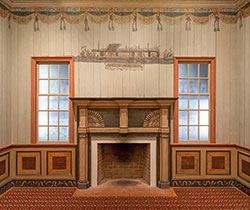
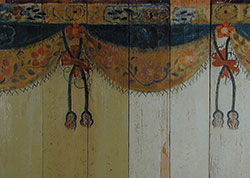
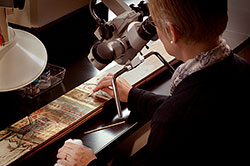
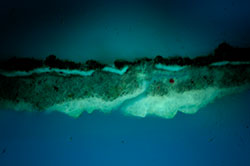
The Carolina Room
The Rex and Pat Lucke Gallery is home to a remarkable room from the Alexander Shaw House. A modest Scotland County, North Carolina, dwelling, its rooms were painted to simulate costly building materials such as cabinet-grade wood and polished stone. The pine doors and wainscoting were grained to look like bird’s eye maple and rosewood, while the baseboards and mantel were painted in imitation of colorful marble. Paint decoration at the top of the walls resembled the exuberant wallpaper borders of that day. Most unusual is the “Vue of New-York” above the mantel. It shows the city’s dockside in flames and was inspired by the fire that destroyed New York’s waterfront in 1835. The decoration was the work of I. M. Scott, who signed and dated the room August 17, 1836.
The woodwork recently underwent complex conservation to preserve, clean, and reveal its original decoration. The work took seven years and was carried out in the Colonial Williamsburg conservation labs. The project consisted of several phases. In the first, conservators reattached loose paint flakes. Next they carefully removed 1950s overpaint to reveal the 1836 decoration below. Soot and grime imbedded in the original paint were removed concurrently. Finally, losses to the decorative scheme were sparingly in-painted. Visitors today will find evidence of this exacting work on exhibition labels and in one area of the room, where the paint was cleaned but not in-painted. Come and inspect the room and the conservation for yourself and see the 180-year-old decoration looking much as painter Scott intended.
The conservation of the Carolina Room was made possible by Mr. and Mrs. Rex A. Lucke of Elkhorn, Nebraska, and the National Endowment for the Arts. Additional conservation support is provided by the Mildred and J.B. Hickman Conservation Endowment and the Andrew W. Mellon Foundation Endowed Conservation Fund.
Ongoing exhibition
-
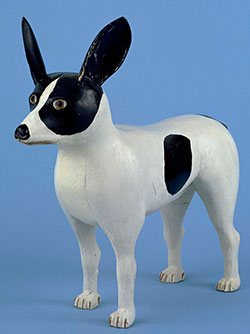
Down on the Farm
This popular exhibition follows the story of Prince, a carved wooden dog, as he sets out on a journey to find his cousin. Rhyming label text tells of his adventures as he travels through the countryside. Colorful folk art paintings by such artists as Mattie Lou O’Kelley and Edward Hicks set the stage for a look at country life as this city dog tries to find his way. On his search, Prince encounters a pond full of carved decoys, a hen yard of toy chickens and a barn complete with wooden owls and a cat. Weathervanes in the shape of farm animals populate the room. Within the gallery, guests can spend time drawing their favorite scene or color pages from Prince’s story.
In the Penelope P. and Dr. Sergio V. Proserpi Gallery.
Ongoing exhibition
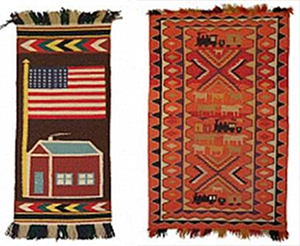
Navajo Weavings: Tradition and Trade
"Navajo Weavings: Tradition and Trade," in the McCarl Gallery features over twenty rare, colorful and pictorial Navajo weavings created by anonymous Navajo women working on hand looms in the late 19th and early 20th centuries. The exhibition showcases a variety of pictorial designs, materials, and symbolic imagery. The earliest object is a man's traditional wearing blanket from about 1860. Later weavings from the early 20th century began to depict the influence of the Anglo world including the incorporation of trains, American flags, and livestock.
The Navajo weavings are on loan to the Art Museums of Colonial Williamsburg from Rex and Pat Lucke. The exhibit is made possible through the generosity of an anonymous donor.
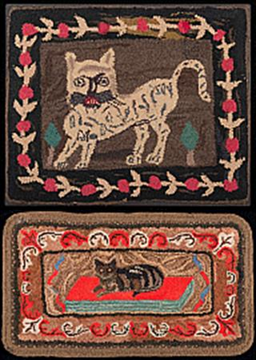
Folk Art Underfoot: American Hooked Rugs
For the first time, the Abby Aldrich Rockefeller Folk Art Museum will feature an exhibition on the art of hooking and sewing rugs, featuring about twenty hooked and sewn rugs. The craft of making non-woven rugs has been called "America's one indigenous folk art." It was in Maine that rug-making techniques originated and grew from their 19th-century origins to a national activity. Rug making gave housewives with no academic art training a way to create an everyday household object with decorative interest and beauty. A special component of the exhibition is a video showing the rug hooking technique.
The American hooked and sewn rugs are on loan to the Art Museums of Colonial Williamsburg from Joseph Caputo. The exhibit is partially funded through the generosity of Larry and Cynthia Norwood.
-
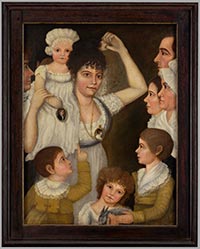
We the People: American Folk Portraits
In this anniversary year, the Folk Art Museum celebrates with a new exhibition featuring a wonderful collection of American folk portraits. One of the first folk art pieces Mrs. Rockefeller acquired was a charming painting of a child. From there, her collection grew. On view will be images of children with their favorite pet or toy, companion portraits of husband and wife, and paintings of individuals. These early American folk portraits are treasured for their historical significance as well as their aesthetic appeal. Without folk painters, the faces of many members of the middle and, sometimes, lower classes would not have been recorded. The portraits reveal much about ordinary people: how they lived, what they valued, and how they wished to be remembered. Folk portraits give us glimpses of the countless people who shaped America as vitally and lastingly as her better known movers and shakers. The artists too left something of themselves. They did not achieve their occupation through formal guidance or direction from others but, instead, through inborn talent and intuition. On view will be old favorites from the collections as well as new acquisitions never before exhibited.
This exhibition is made possible through the generosity of Don and Elaine Bogus.
In the Jan Curtis and Frank J. Spayth Gallery
Related Programming
Introduction to Folk Art - Discover whimsical and fascinating paintings, sculpture, and textiles from Mrs. Rockefeller's collection on this guided tour. These pieces are the basis of the museum's original collection. Offered daily.
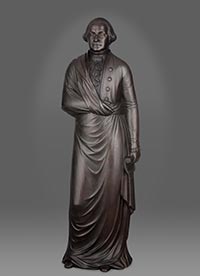
From Forge and Furnace:
A Celebration of Early American IronCan iron and art be used in the same sentence? Absolutely! This hard, often black or gray, metal was used to make everything from stoves and hinges to andirons and weathervanes. As with most folk art, though, the makers of these utilitarian pieces chose to embellish their work to make them interesting and attractive although no more functional than if they left them unadorned. A stove could still heat a room whether it was a simple iron box or iron cast into a statue of George Washington. This exhibition highlights these decorative, yet useful, objects made in the eighteenth and nineteenth centuries. Iron mining and iron production were established in the colonies almost as soon as settlers arrived. By the American Revolution, Virginia had several furnaces providing the iron that was made into firebacks, stoveplates and a myriad of household items like ladles, toasters, trivets and tammels.
In the Peebles Gallery
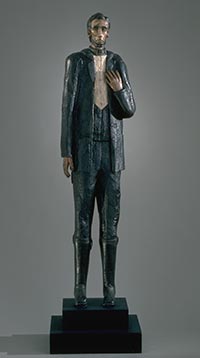
America's Folk Art
As the oldest museum in the country devoted to American folk art, the Abby Aldrich Rockefeller Folk Art Museum has exhibited art for over 60 years. America's Folk Art celebrates this long history of collecting and displaying folk art, but also pays tribute to Mrs. Rockefeller who began collecting folk art in the 1920s. Her keen eye and appreciation for the art of the common man created a collection of over 400 pieces that were eventually given to Colonial Williamsburg. Over the ensuing years, the collection has grown to over 4000 objects that date from the 18th century to the present day. This exhibition showcases iconic images from Mrs. Rockefeller's original collection, like Baby in Red Chair, as well as some of the most recent additions, like the colorful Peaceable Kingdom by artist Malcah Zeldis.
In the Spayth Gallery
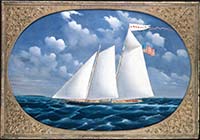
American Ship Paintings
This exhibition of 5 paintings from the Folk Art collection highlights the popularity of ship portraits. In the mid-19th century, ship captains and owners commissioned artists to depict their sea-going vessels in all their glory. Included in the exhibit are 3 large paintings by James Bard, one of which depicts the schooner yacht America, the first winner of the trophy now known as the America's cup. Steamboats plied the rivers of 19th-century America and are represented in the exhibit in two paintings, one of which is over 6 feet long, giving an impressive, detailed view of the side-wheeler. Each portrait depicts a specific ship with a story to tell.
Ongoing
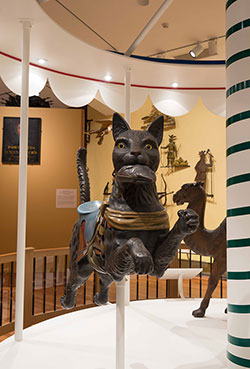
Sidewalks to Rooftops
Ever wonder what it was like to stroll down the streets in late 19th-century America? Looking up, one might see a carved and painted oversized pair of glasses or a weathervane atop a building in the shape of a fish. On the sidewalk, one might encounter a life size wood figure of an Indian maiden or a Cuban lady standing outside a shop advertising tobacco within. Strolling down by the wharf, one could admire the carved figureheads and wooden eagles that decorated many of the wooden ships at dock. In the 20th century, some of these signs disappeared from the landscape while others took their place. Large whimsical carved animals awaited riders on carousels. Fanciful whirligigs and wooden ornaments adorned people’s yards. These 19th- and 20th-century works survived the elements and bear witness to the creative spirit that once enlivened the American landscape.
This exhibition was made possible in part by a gift from Barry M. Boone in loving memory of his wife, Linda.
In the Leslie Anne Miller and Richard B. Worley Gallery
